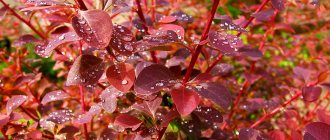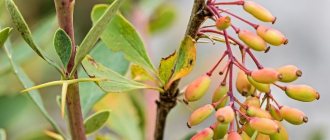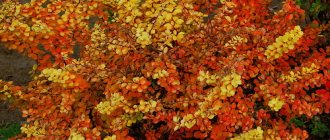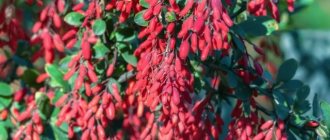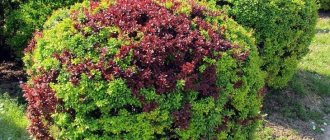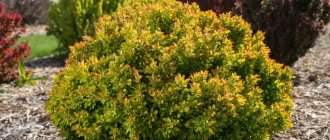Picturesque shrubs that decorate garden plots often serve as vegetable hedges and even borders. Barberry is attractive with its brightly colored multi-colored foliage and sour berries, rich in vitamins, used in folk medicine and suitable for delicious home preserves. Growing shrubs is not difficult and does not take much time. One of the most popular varieties in Russia, the Thunberg barberry Bagatel, differs from other species in its small size. It corresponds to the exact translation from French: the name means “trinket.”
Description of Barberry Bagatelle
The plant is a dwarf shrub in the shape of a compact ball up to 30 cm high and 60 cm in diameter with red-brown bark with thorns and small leathery foliage of oblong shape, covered with dense shiny skin. The color of the leaves in the sun is usually purple or deep red, in a shaded place - with a green tint. Often the sheets are covered with contrasting spots or surprise with a relief border. In autumn they become bright carmine, and in winter the bush loses its foliage.
Design
The shrub blooms in late spring - early summer with miniature yellowish flowers grouped into inflorescences. Fruit ripening occurs in September. The edible berries of the Thunberg barberry Bagatelle are elongated, covered with shiny skin, and have a pleasant sour taste.
Red
Reviews
There are few reviews of Thunberg’s barberry “Bagatelle” and in general they confirm what was said above:
- Moscow region, outskirts of Klin: “Bagatelle” turned green in the shade of the house and had to be transplanted into a flowerbed;
- Moscow: it grows, every year the young stems freeze and then stick out like antennae, they have to be cut off;
- Belarus, Minsk region: grows in a group with junipers, very beautiful, bright;
- Moscow: we cover it with spandbond every year, there are no problems with freezing.
If you also grew this barberry, please leave your feedback in the comments to the article. It will be useful to other readers.
Planting a plant
The ornamental shrub is unpretentious to growing conditions, does not require special care, and is not afraid of wind and sun.
When to plant
Barberry bush - types, varieties, planting and care
The time for transferring barberry to the site is selected depending on the condition of the planting material. A bush purchased directly in a container with soil can be replanted at any convenient time, even in summer. It is important to pay attention to the main points:
- It is advisable to replant in cool weather;
- At first, you should shield the young bush from the direct rays of the sun.
Berberis thunbergii seedlings removed from the soil are usually transplanted into open ground in early spring, when the buds have not yet begun to bloom. It is not recommended to plant at a later date so that the plant takes root better and does not get sick.
Note! You can plant bushes in September. The plant adapts well even in cold Siberian conditions.
wild
Selection of location and soil
Thanks to the unpretentiousness of the Tunberga barberry, it feels equally good:
- in low-lying valleys;
- under the cover of fences;
- in the light shade of trees;
- on windy hills.
Placement in the shade is favorable for species with green-yellow leaves that cannot tolerate direct sunlight. Red-leaved varieties, on the contrary, need good lighting. Without it they will lose their picturesqueness.
Barberry Bagatelle can take root in almost any soil, with the exception of acidic soil. It takes root even on sandy and rocky soil, but prefers fertile neutral soil, which should certainly be limed before transplanting the bush into it. It is best to first add substances that reduce the acid composition of the soil immediately into the hole dug for the bush. Experienced gardeners advise planting the plant in a substrate consisting of turf soil, supplemented with:
- sand;
- humus (or compost);
- 200 g calcium oxide hydrate (slaked lime);
- 200 g peat (or wood ash);
- superphosphate (100 g).
Important! If the soil is naturally acidic, there is no need to add ash and lime.
The shrub does not tolerate high humidity; it will not feel comfortable in swampy, flooded lands or in places with close groundwater. In such cases, usually high flower beds or ridges are created for growing barberry. In alumina, planting holes are dug 10 cm deeper, and the bottom is covered with drainage pebbles.
Fencing
How to plant without mistakes
Holes measuring 40x40 cm are dug in advance - 15-20 days before planting. Due to the rapid growth of shrubs, they are placed at a minimum distance of one and a half meters. When installing a living fence, the gap can be reduced to half a meter. During the planting process:
- Drainage and sand are poured into the bottom of the hole.
- Fill the hole with the prepared nutrient mixture.
- Generously moisten with moisture.
- A plant seedling is placed in the hole.
- Carefully straighten the roots.
- Add the remaining soil.
Experts suggest mulching the tree trunk circle with peat or compost to create favorable conditions for the young bush - retaining moisture and nutrients.
Additional Information! For better rooting, barberry seedlings are pruned to 3-5 strong buds.
Edible species
No home garden is complete without fruit trees. Even the laziest gardeners plant their plots with raspberries, apple trees, and pears, but few people prefer such an unpretentious plant as barberry. In addition to its nutritional value, it is also worth noting its healing and decorative properties.
Common barberry
The most common barberry is in the Caucasus and Southern Europe, but it can also grow in Siberia. Shrubs of this species are frost-resistant and can withstand temperatures down to -35 degrees. The main condition for growing is to place the plants in sunny and dry areas. Planting in the shade negatively affects the taste and quantity of fruits.
Common barberry is one of the most common members of the family, which is distinguished by its unpretentiousness and high frost resistance.
The common barberry has quite a few varieties, namely:
- Lutea is a bush up to 2 m high with yellow shoots and light green foliage. The fruits are golden yellow and sour. It should be planted only in open sunny areas of the garden.
- Aureomarginata - can reach a height of 3 m, has very beautiful leaves, edged with a golden stripe. Very effective in hedges. The fruits are scarlet, tasty, sweet and sour, ripen in October.
- Atropurpurea - the height of the bush does not exceed 2 m, the shoots are purple with dark red leaves and fruits. A very impressive plant. Berry picking is carried out at the end of September - beginning of October.
- Alba variegata - this variety is valued for its high decorative properties. Its foliage is “painted” with white streaks, the color of the fruits is creamy white.
- Dulchiz - has all the species characteristics of the common barberry, and is distinguished by the high taste qualities of the fruit. The berries are sweet and fully ripen by mid-October.
- Asperma is a tall bush with red seedless berries.
How to care for Barberry Bagatelle
Barberry Green Carpet - variety description and care
The ornamental shrub is famous for its undemanding nature, but there are certain subtleties of care, without which it is impossible to achieve its magnificent appearance.
Border
Watering
The bush requires irrigation only in hot weather. For him, a lack of water is better than too much water. In cool times, the bushes have enough natural precipitation. In the hot season, a bucket for each bush twice a month is enough. Immediately after planting, Bagatelle barberry, as described by professionals, must be moistened until complete rooting 1 to 2 times a week.
Important! You should not water the plant with cold water from the tap. It should sit in a barrel and heat up in the sun.
During the watering process, you must try to ensure that moisture does not fall on the foliage, but is directed under the roots. Experienced gardeners arrange drip irrigation for barberry.
Top dressing
The shrub responds well to feeding, although in the first 2 years fertilizers are not required - those applied during planting are sufficient. In the spring, during the period of rapid growth and flowering, it needs nitrogen. To do this, dilute 30 g of the product in a 10-liter container. The procedure is repeated every 3 or 4 years. Phosphorus and potassium fertilizers are applied in the summer, when fruit sets, and in the fall, after ripening and harvesting.
Trimming
Like all ornamental shrubs, Bagatelle barberry should be pruned to:
- maintaining a spherical shape;
- growth stimulation;
- eliminating dry shoots;
- increasing productivity.
The compact shape of the plant, collected in hedges, allows you to avoid pruning to give it a beautiful shape. Individually growing bushes are usually given the shape of a ball. In the spring, sanitary treatment is carried out, removing dry, frozen and diseased stems. Formative circumcision is required twice a year - in June and August. Remove from a third to 2/3 of the stem length.
Globular
Flowering period
Barberry Bagatelle blooms in May or June with numerous small yellowish flowers up to 1 cm in diameter, collected in racemose inflorescences. The bush is covered with them for 3 weeks, but usually they are difficult to notice among the lush crown.
Varietal diversity
Today, gardeners cultivate many varieties of Thunberg barberry. Among the varieties that are in greater demand, several varieties should be noted.
Aurea
A shrub of regular shape, reaching a height of 70-80 centimeters. This culture is distinguished by its slow pace of development, which will be a big plus for some garden compositions. Berberis thunbergii Aurea is distinguished by its good survival rate and compatibility with other garden crops, which allows you to create beautiful colorful compositions in the garden. The green mass of the variety is diamond-shaped and has the characteristic ability to change its color from gold in spring to orange with the arrival of autumn. In areas where shade predominates, barberry will have a green color to its leaves.
Erecta
A columnar-shaped bush that can grow in height up to 1 meter. Shoots develop in a horizontal position, but side branches can grow at a slight angle. The variety is notable for the bright green color of its leaves, resistance to negative temperatures, and ability to develop when planted in a mixborder.
Green carpet
A cushion-shaped variety of barberry, in which shoots develop in different directions. The height of the crop reaches 50-60 centimeters, while the width of the shrub can grow up to one meter. The color of the green mass of barberry will be light green, the crown has a spherical shape. At the end of the summer months, barberry changes the color of its leaves to red. According to the description of the shrub, it is unpretentious in terms of care and is recommended for growing in the middle zone. It reaches its peak of decorative appeal during group plantings with coniferous or deciduous crops, in flower beds located on hills or slopes.
Golden ring
Barberry with purple leaves edged with gold. The crop tolerates frost well and is most often used in border compositions and also as a hedge.
Red rocket
Variety with purple leaves. The crown of the bush has a columnar shape. As a rule, the height of an adult plant is within one meter. The shoots develop strictly horizontally and contain smaller lateral branches. The variety can be used in single or group plantings. As for resistance to negative temperatures, this crop has average characteristics, so it is suitable for growing in mild climates with warm winters.
Bagatelle
A shrub with a spherical crown, having a brown-red color of green mass. The plant is small in size. As a rule, the height of an adult bush reaches 40-50 centimeters. Over the course of a year, it increases by only a couple of centimeters. In spring and summer, the leaves of barberry will be dark with a pink tint; inside the shrub has green foliage, which remains unchanged in color even with the arrival of autumn.
Admiration
The most popular variety of barberry, standing out for its beauty. The crown of the plant has a spherical shape, the height reaches 30-40 centimeters. The bush grows quickly - within a year, barberry can increase in height by 3-4 centimeters, while the plant will become 2 times larger in width. The variety belongs to the light-loving varieties of barberry and is undemanding to the type of soil.
Maria
When planting this barberry, it is worth considering that the bush grows its shoots quite slowly. The branches develop horizontally; as a rule, the height of an adult bush is 150 centimeters. The crown will be columnar and dense; young shoots are usually pink and orange. The green mass has a yellow tint with a pink border around the edge; in the fall the bush will be bright orange. Flowering occurs in May, while the fruits ripen only in October. For the culture, it is worth selecting sunny areas in the garden; barberry quickly recovers after cutting and can act as a topiary crop. The variety is frost-resistant and can be used to create border compositions and rock gardens.
In addition to the above varieties of Thunberg barberry, gardeners grow the following varieties:
Kobold
Reproduction methods
Shrubs are propagated in four main ways:
- seed;
- cuttings;
- dividing the plant;
- using layering.
Barberry Maria - description and cultivation
The seeds are extracted from the fruits after ripening. In autumn the seeds:
- Extracted from berries.
- Place in potassium permanganate for 2-3 minutes.
- Dry it.
- Sow into the ground to a depth of 1 cm.
In the spring season, the first shoots appear. After two true leaves appear, they must be thinned out, leaving a gap of at least 3 cm between the seedlings. After 2 years, the shrubs are transplanted to a permanent place.
Additional Information! When sowing barberry in spring, the seeds are stratified. To do this, they are mixed with sand and kept in the refrigerator for 3-5 months at a temperature of 2 to 5 degrees.
Seed propagation requires a lot of time and labor.
With the cutting method of propagation, which is best done early in the morning, the shoots:
- Cut from the bush at the end of June.
- The bottom leaves are torn off.
- Dip the tips of the branches into a growth stimulating agent.
- After washing, place it in a nutrient substrate.
To root the sprouts, it is necessary to maintain soil moisture and a greenhouse environment by covering with film. From time to time it needs to be opened slightly for ventilation. After 2 years, the young bush is transplanted to a permanent place.
The simplest way to propagate barberry is by layering. To receive them in the spring:
- Dig a surface groove next to the bush.
- Bend down and place the strongest lower shoot into it.
- Fill the ditch with soil.
One top will remain on the surface. It will take root over the summer. A fresh bush can be transplanted to a permanent site.
Plant division is used for low 3-5 year old bushes with a root collar buried 10 cm into the ground. The bush is dug out of the ground and divided into equal parts, carefully separating the roots and trying not to damage them. Sections should be treated with crushed charcoal.
Bagatelle
Application
Barberry is a plant widely used in the following areas due to its beneficial properties.
Medicine
Infusions and medicines from the root and leaves are used not only for medicinal purposes as an antispasmodic (treatment of the gallbladder) and an antiseptic, for blood clotting, stopping bleeding and treating blood vessels, but also help during the first birth, accelerating uterine contractions.
Barberry beneficial properties
Gardening
Thanks to its natural thorns, the shrub is useful as a living fence for a garden or garden plot against uninvited guests. Wood is used to create paint.
Cooking
Due to the presence of malic, citric and tartaric acids in the berries, sweet desserts, syrups, compotes, liqueurs and candies are prepared from them. The green mass can be used for pickling.
Cosmetology
On a note. The essential oil extracted from the fruit is used to make nourishing and scented masks.
Infusions from leaves - to strengthen the scalp. Berry decoctions strengthen hair.
Preparing for winter
The shrub is distinguished by its winter hardiness: under the cover of snow it tolerates frost well, although it is not very comfortable under the snowdrifts for a long time. In a snowless winter, the plant may freeze. Experienced gardeners advise covering young plants with spruce branches, straw or special fabric, just in case. At the end of autumn, it is advisable to mulch the root soil with dry leaves, sawdust, and compost.
Flowerbed
Use in landscape design
Due to the variety of foliage colors, you can get all sorts of interesting combinations, turning the site into a real greenhouse. Even an ordinary amateur can do this task. Barberry Bagatelle is very popular among landscape designers due to its seasonal changes in appearance. It is used to design:
- living fences and borders;
- rock gardens and flower beds;
- balconies and terraces;
- group compositions.
Additional Information! The value of barberry for urban design and landscaping lies in the fact that it perfectly tolerates polluted and dusty city air.
Pests and diseases
Barberries rarely suffer from diseases or pests, and the Bagatelle variety is no exception. But sometimes it is affected by the following infections: powdery mildew, bacterial cancer, rust, bacterial necrosis of the bark, leaf spot.
Therefore, in April it is recommended to carry out preventive treatment of Bagatelle barberry bushes with any effective means:
- Bordeaux mixture;
- "Fitoverm";
- "Skor";
- "Maksim";
- "Tattu";
- "Ridomil Gold".
Among the pests, the barberry aphid is the most dangerous. Rarely, moths and barberry sawflies attack bushes. If pests are detected, the plants are immediately treated with insecticides: “Aktellik”, “Aktara”, “Decis”, “Biotlin”, “Iskra”.
Important! Treatment of bushes is carried out in the evening, in dry and windless weather.
Beneficial features
Traditional medicine has been using a plant rich in vitamins since ancient times. Recipes for medicines from Bagatella barberry are found in Indian, Chinese, and ancient Greek manuscripts. Medicines are prepared from bark, roots, leaves, but berries are especially useful. The plant contains:
- pectin, which helps get rid of toxins;
- vitamin C;
- fruit acids (malic, citric, tartaric);
- serotonin (chemical mood regulator);
- Berberine is an alkaloid with antimicrobial effects.
Multicolored
Herbal remedies are used in the form of decoctions, infusions, and teas. The fruits have a lot of healing qualities:
- choleretic;
- mild laxative effect;
- antipyretic;
- thinning and removing phlegm;
- antiemetic;
- immunostimulating;
- tonic;
- antioxidant;
- antispasmodic;
- painkillers.
Important! Like all herbal remedies, barberry can cause an allergic reaction. Therefore, before starting use, you should consult your doctor.
In addition to medicine, the juice of the plant is successfully used in cosmetology to reduce wrinkles and smooth the skin, for hair care and eliminate dandruff.
Helpful information! The shrub is a wonderful honey plant that attracts all the surrounding bees.
Thanks to its picturesque red leaves of different shades and unpretentiousness of cultivation, Thunberg's barberry is successfully used for decorating garden plots and fences. Tasty drinks, desserts and traditional medicine are prepared from sour berries, rich in vitamins.
Evergreen beauties for the flower garden
Along with deciduous barberries, such as Thunberg barberry, there are also evergreen species. We have already mentioned one of them. This is boxwood barberry (Berberis buxifolia) 'Nana' - a dwarf shrub only 50 cm high. It is perfect for low hedges.
At a height of 1.5 m, the Frikart barberry (Berberis frikartii) 'Amstelveen' remains compact.
Barberry Frickart 'Amstelveen' It grows mainly in partial shade, as does Gagnepain barberry (Berberis gagnepainii) 'Klugowski', the branches of which slope picturesquely to the ground as they grow.
Gagnepein's barberry 'Klugowski' For a dense hedge of a meter in height, the dove-white barberry (Berberis candidula) 'Jytte' with a dense cushion-shaped crown is perfect.
Barberry dove-white 'Jytte'
